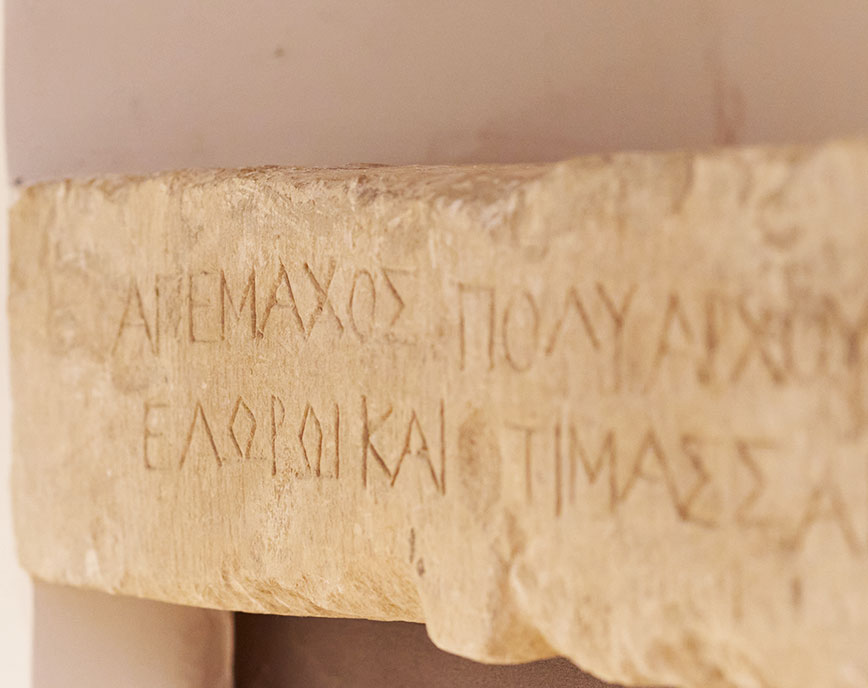The Greek city of Helorus (Héloros) was the first sub-colony founded by the Syracusans at the end of the 8th century B.C., to the north of the mouth of the river of the same name, now known as the Tellaro, where the port area was located.
The centre was connected to Syracuse by an important coastal road, the Via Elorina, the main N – S thoroughfare which intersected at right angles with minor roads on an E-W axis and led to the South Gate. The city had a double curtain wall with square towers, while a small agorà was at the highest and most central point of the city.
The southern part of the city was dominated by the Urban Sanctuary of Demeter with a large Doric temple.
To the north-west of the sanctuary, there was a small temple with an altar, possibly dedicated to Asclepius.
The remains of a number of ancient dwellings, dating from the late 8th century B.C., are older than the Sanctuary.anfora SOSAmong the oldest artefacts are the SOS amphora, proto-Corinthian or imitation vases and the fragments of two Etruscan plates of Caeretan production.
Because of the urban transformation of the second half of the 4th century B.C., the focal point of the area became the sanctuary with its large Doric temple dedicated to Demeter. Here, a gold ring with a carnelian scarab was found. At the beginning of the 2nd century B.C., the sanctuary was monumentalised with a colonnaded portico in a double order (Doric and Ionic) with two asymmetrical wings. The sima of the stoà was decorated with limestone lion’s head protome pseudo-drips. The structures and architectural decorations of the sanctuary were clad in polychrome stucco and the rooms were lit by oil lamps, such as the large umbrella-shaped fictile oil lamp found in Room 5.
A fine female head in white marble, dating from the 2nd century B.C., was found in a cistern of the Sanctuary, which has a delicate polychrome decoration. When the sacred site was abandoned in the 6th century A.D., a Byzantine basilica was built.
The Koreion
Outside the urban walls, on the north beach of Eloro, the Koreion, the Sanctuary dedicated to Demeter and Kore, was found; it was studied by Maria Teresa Currò in 1964.
The Koreion, whose Room B is hosted in MuCiAN today, had six rooms where the Thesmophoria feasts were celebrated. Inside and outside there were benches used for, among other things, the deposition of offerings, also placed in over sixty sacred pits. It is interesting to note that the ex votos were buried and placed inside over sixty sacred pits.
In the Koreion countless terracotta figurines have been found, depicting a female figure with a torch and a pig, some with traces of coloured pigments.
A model of a limestone temple was also found under a bench outside Room B of the sanctuary. There is evidence of the cult of chthonic divinities in the Koreion dating to the 7th and 3rd centuries BC, with a decline in the 5th century BC.







The Necropolises
There are four Necropolises of Helorus: A, B, C and D. In the first one, Paolo Orsi investigated a rectangular tomb (grave A 1) from the early 5th century B.C.
The deceased had on either side of his head an Attic vase and a black-figure jug with dancing Satyrs and Bacchae in honour of Dionysus, god of wine and theatre, crowned with ivy, symbol of life, against a background of vine shoots, symbol of death.
The other necropolises flanked the Via Elorina, a kind of sacred road, along the outside section of the city. In Necropolis C a monumental column (10.50 m) stands, known as the ‘Colonna Pizzuta’, built in memory of an eminent individual. Originally enclosed by a limestone balustrade, it stands over a hypogeum chamber tomb containing three graves. One of the deceased bore a bronze coin of Hiero II from the second half of the 3rd century B.C. Near Necropolis D there are the Heroa, places of worship for the heroised dead, of which countless small paintings (pinakes) remain, carved into the rock walls of former stone quarries.